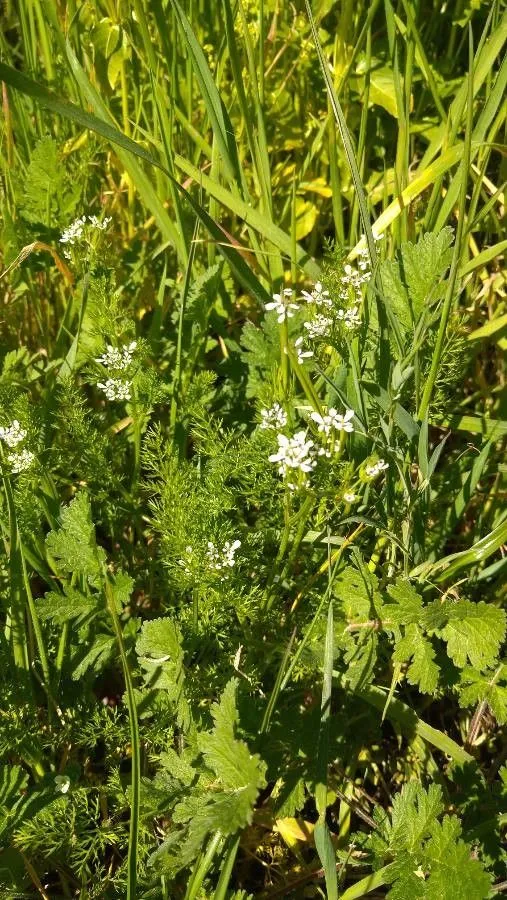
Author: L.
Bibliography: Sp. Pl.: 256 (1753)
Year: 1753
Status: accepted
Rank: species
Genus: Scandix
Vegetable: False
Observations: Europe, Macaronesia to NW. India
Shepherd’s-needle, scientifically known as Scandix pecten-veneris, is a fascinating and delicate plant belonging to the Apiaceae family. Described by Carl Linnaeus in his seminal work “Species Plantarum” in 1753, Shepherd’s-needle has piqued the interest of botanists and plant enthusiasts for centuries.
This species is widely distributed across Europe, extending from the lush landscapes of Macaronesia all the way to the northwestern regions of India. Its adaptability to various environments showcases the plant’s resilience and versatility.
Shepherd’s-needle is particularly noted for its slender, needle-like fruits, which are reminiscent of the needles used in textiles—hence the common name. This characteristic makes it easily recognizable and adds a unique charm to the flora where it is found. The plant’s foliage is equally captivating, with finely divided leaves that provide a delicate, lace-like appearance.
In traditional botanical studies and observations, Scandix pecten-veneris is admired not only for its aesthetic qualities but also for its ecological significance. It often inhabits fields, grasslands, and open spaces, contributing to the biodiversity of these ecosystems. Additionally, its flowers attract a variety of pollinators, playing an essential role in sustaining the local insect populations.
For plant lovers and gardeners, Shepherd’s-needle represents a touch of historical and botanical elegance, tracing back to the early documentation by Linnaeus. Its presence in gardens and natural landscapes continues to be a testament to the enduring beauty and ecological importance of this remarkable species.
Dan: ager-kål, jomfrukam, sort sennep, takkeklap, raps
Deu: echter venuskamm, gewöhnlicher venuskamm, nadelkerbel, venuskamm, venuskamm-nadelkerbel
Fin: idänukonpalko, mustasinappi, peltokaali, rapsi
Nor: russekål, svartsennep, raps, åkerkål
Swe: ryssgubbe, svartsenap, nålkörvel, raps, åkerkål
Eng: shepherd’s-needle, shepherdsneedle, venus’s-comb, shepherd’s needle, sheperd’s needle, venus’ comb, lady’s venus-comb
Est: metsputk
Nld: naaldenkervel
Fra: peigne-de-vénus, peine de vénus, scandix peigne de vénus
Ces: vochlice hřebenitá
Cym: nodwydd y bugail
En: Shepherd’s-needle, Venus’s-comb, Shepherd’s Needle, Shepherdsneedle, Shepherd needle, Àckerschtrahl, Sheperd’s needle, Venus’ comb, Lady’s Venus-comb
Ar: مشط الراعى (مِشط الراعى), مشيطه (مَشيطه، مِشيطه)
Ca: Agulles de pastor, Fila-barba
Kw: Naswydh a’n tregher
Cs: Vochlice hřebenitá
Da: Ager-Kål, Jomfrukam, Sort Sennep, Takkeklap, Raps
Nl: Naaldenkervel, Naaldekervel
Et: Kamjas nokkputk, Metsputk
Fi: Kampasarjaputki, Idänukonpalko, Mustasinappi, Peltokaali, Rapsi
Fr: Peigne-de-Vénus, Peigne de Vénus, Peine de vénus, Scandix peigne de Vénus, Scandix peigne-de-Vénus, Aiguillette
Gl: Agulleira
De: Nadelkerbel, Gewöhnlicher Nadelkerbel, Venuskamm, Echter Venuskamm, Gewöhnlicher Venuskamm, Venuskamm-Nadelkerbel, Nabelkerbel
He: מסרק שולמית
It: Acicula comune, Pettine di Venere, Spillettoni
No: Russekål, Svartsennep, Raps, Åkerkål
Oc: Agulhas
Fa: شاهونوس
Pl: Czechrzyca grzebieniowa
Ro: Acul-doamnei
Ru: Скандикс гребенчатый
Sk: Česák hrebenitý
Es: Aguja de Venus, Peine de Venus
Sv: Nålkörvel, Ryssgubbe, Svartsenap, Raps, Åkerkål
Cy: Nodwydd y bugail
© copyright of the Board of Trustees of the Royal Botanic Gardens, Kew.
© copyright of the Board of Trustees of the Royal Botanic Gardens, Kew.
© copyright of the Board of Trustees of the Royal Botanic Gardens, Kew.
Taken Mar 8, 2021 by Antonio López Rodríguez (cc-by-sa)
Taken May 7, 2021 by Llandrich anna (cc-by-sa)
Taken Apr 22, 2018 by huy HO (cc-by-sa)
Taken Mar 21, 2018 by Mehmet Basbag (cc-by-sa)
Taken Mar 23, 2019 by Denis Bastianelli (cc-by-sa)
Taken May 12, 1998 by Tela Botanica − Liliane ROUBAUDI (cc-by-sa)
Taken May 12, 1998 by Tela Botanica − Liliane ROUBAUDI (cc-by-sa)
Taken May 12, 1998 by Tela Botanica − Liliane ROUBAUDI (cc-by-sa)
Taken May 7, 2021 by Llandrich anna (cc-by-sa)
Taken Apr 22, 2018 by huy HO (cc-by-sa)
Taken May 7, 2021 by Llandrich anna (cc-by-sa)
Taken Mar 15, 2022 by Stéphane Mars (cc-by-sa)
Taken Mar 18, 2020 by Emmanuel Cosson (cc-by-sa)
Taken Apr 1, 2018 by ZHUN MAO (cc-by-sa)
Taken Mar 8, 2021 by Antonio López Rodríguez (cc-by-sa)
Taken Nov 17, 2022 by niels jansen (cc-by-sa)
Taken Apr 20, 2017 by Yoan MARTIN (cc-by-sa)
Taken Nov 22, 2022 by Kilhiann Bagur (cc-by-sa)
Taken Apr 30, 2022 by Светлана Светлана (cc-by-sa)
Taken May 7, 2021 by Llandrich anna (cc-by-sa)
Taken Apr 20, 2017 by Yoan MARTIN (cc-by-sa)
Taken May 12, 2018 by Miguel A. C. (cc-by-sa)
Taken Apr 30, 2022 by Светлана Светлана (cc-by-sa)
Taken Mar 11, 2020 by Roxane Decrock (cc-by-sa)
Taken Feb 21, 2020 by Marie-Claude Deboin (cc-by-sa)
Taken Mar 26, 2020 by Christopher Kontaratos (cc-by-sa)
Taken Feb 9, 2022 by Fabrizio (cc-by-sa)
Taken Apr 20, 2022 by Raúl (Este Madrid) (cc-by-sa)
Taken Apr 22, 2022 by Hélène Illaire (cc-by-sa)
Taken Apr 16, 2012 by Tela Botanica − Geneviève Botti (cc-by-sa)
Growth habit: Forb/herb
Ph maximum: 8.0
Ph minimum: 7.5
Light: 8
Atmospheric humidity: 3
Bloom months: [‘may’, ‘jun’, ‘jul’, ‘aug’]
Soil nutriments: 6
Family: Myrtaceae Author: (F.Muell.) K.D.Hill & L.A.S.Johnson Bibliography: Telopea 6: 402 (1995) Year: 1995 Status:…
Family: Rubiaceae Author: Pierre ex A.Froehner Bibliography: Notizbl. Bot. Gart. Berlin-Dahlem 1: 237 (1897) Year:…
Family: Sapindaceae Author: Koidz. Bibliography: J. Coll. Sci. Imp. Univ. Tokyo 32(1): 38 (1911) Year:…
Family: Asteraceae Author: A.Gray Bibliography: Pacif. Railr. Rep.: 107 (1857) Year: 1857 Status: accepted Rank:…
Family: Fabaceae Author: Medik. Bibliography: Vorles. Churpfälz. Phys.-Ökon. Ges. 2: 398 (1787) Year: 1787 Status:…
Family: Aspleniaceae Author: (Cav.) Alston Bibliography: Bull. Misc. Inform. Kew 1932: 309 (1932) Year: 1932…